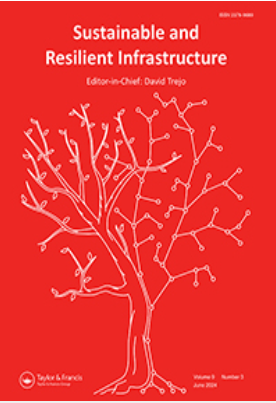相互依赖的废水处理基础设施的财政分配和网络恢复:弹性指标的发展
IF 2.2
Q2 ENGINEERING, CIVIL
引用次数: 0
摘要
当面临洪水时,污水处理厂(WWTPs)的性能中断会导致城市系统功能的并发症。因此,公用事业公司需要提高其设施的恢复能力,并制定资产恢复计划。本研究旨在探讨两个指标,以提高污水处理厂的弹性。利用模糊多准则决策框架设计了一个基于属性的弹性度量,以获得预算分配方案。还制定了表示相互依赖的基础设施的网络模型,以开发基于性能的度量。模拟灾后网络行为,得到资产恢复序列(RS)。结果表明,在分配资金时,考虑专家意见的不准确性可以降低低估或高估弹性改善的可能性。此外,优先考虑设施的恢复将增加污水处理厂的恢复能力。提出的方法在布鲁克林进行了测试,为资产管理中的一些挑战提供了一个有弹性的解决方案,可以适用于其他沿海环境。本文章由计算机程序翻译,如有差异,请以英文原文为准。
Financial allocation and network recovery for interdependent wastewater treatment infrastructure: development of resilience metrics
ABSTRACT The disrupted performance of wastewater treatment plants (WWTPs) when facing floods can cause complications in urban systems’ functioning. Therefore, utilities need to improve the resilience of their facilities and establish asset restoration plans. The present study aims at investigating two metrics to improve the WWTP’s resilience. An attribute-based resilience metric is devised using a fuzzy multi-criteria decision-making (FMCDM) framework to attain a budget allocation proposition. A network model representing the interdependent infrastructure is also formulated to develop a performance-based metric. The network’s post-disaster behavior is simulated to obtain an asset restoration sequence (RS). The results indicate that considering imprecisions in experts’ views lowers the possibility of underestimation or overestimation of resilience improvement when allocating funds. Furthermore, prioritizing facilities’ restoration will increase WWTPs’ resilience. The proposed methodology, which is tested on Brooklyn, provides a resilient solution to some challenges in asset management and can be applicable to other coastal settings.
求助全文
通过发布文献求助,成功后即可免费获取论文全文。
去求助
来源期刊

Sustainable and Resilient Infrastructure
ENGINEERING, CIVIL-
CiteScore
7.60
自引率
10.20%
发文量
34
期刊介绍:
Sustainable and Resilient Infrastructure is an interdisciplinary journal that focuses on the sustainable development of resilient communities.
Sustainability is defined in relation to the ability of infrastructure to address the needs of the present without sacrificing the ability of future generations to meet their needs. Resilience is considered in relation to both natural hazards (like earthquakes, tsunami, hurricanes, cyclones, tornado, flooding and drought) and anthropogenic hazards (like human errors and malevolent attacks.) Resilience is taken to depend both on the performance of the built and modified natural environment and on the contextual characteristics of social, economic and political institutions. Sustainability and resilience are considered both for physical and non-physical infrastructure.
 求助内容:
求助内容: 应助结果提醒方式:
应助结果提醒方式:


